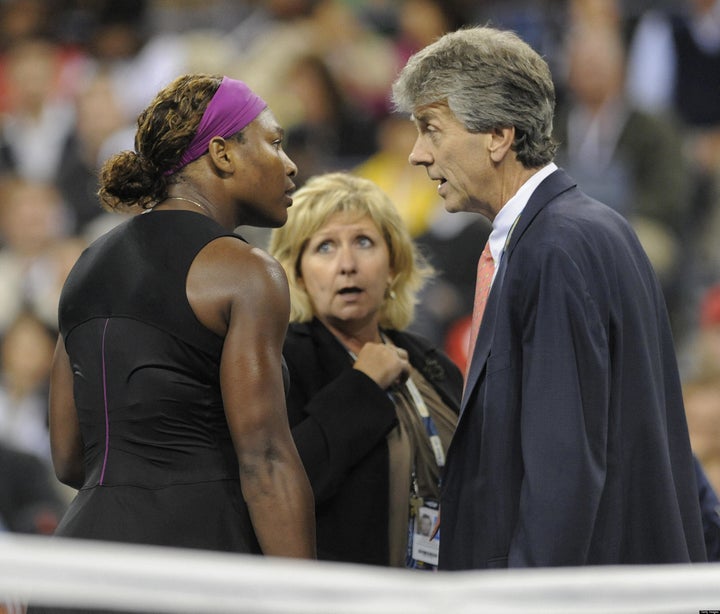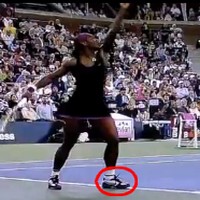

It seemed like a no-brainer in 2006 when the U.S. Open became the first Grand Slam tournament to institute the Hawk-Eye technology for player challenges. After all, it added an entirely new dimension and layer of intrigue and resolution to the game for players, fans, viewers at home and even sponsoring advertisers. Unlike other sports such as football, the replay in tennis is really instant. In a matter of seconds you'd know in from out without having to look at ten different angles. There was something nice and simple about the efficiency of the Hawk-Eye, albeit far less interesting and analytical than the joys and tribulations that come with the coaches challenge in football on any given Sunday. It wasn't until recently during this year's Open that it occurred to me, maybe the tennis challenge has its faults. Maybe there's even something that the WTA, USTA and umpires can learn from the the NFL. My speculation and curiosity with the challenge was incited on two fronts. The first being the sheer frequency of player challenges and calls overturned, and second, the Serena Williams foot fault debacle. On some level, as you'll see there may even be a corollary between the two.
On the matter of frequency, it seems that virtually every call is now challenged, close or not so close. If a player has nothing to lose but that match, their last resort becomes the challenge just because they can. However, what's more alarming is the frequency to which these calls are overturned. I haven't been counting, who can, but I think a rough average for calls overturned sits somewhere between 30-35%. On one hand, it makes you wonder, what would McEnroe's call turnover percentage have been, but the important question raised is how much has instant replay detracted from court umpires' call-making acumen? We can't go back in time and compare then and now, but we've all bared witness to shots called in or out that should have been blatantly obvious without replay. Essentially, umpires have been taken off the hook and in turn been made less accountable for their judgment. It's natural, I suppose. Why do the spell check manually when MS Word will do it for you. However, when you're dealing with a professional sport and hundreds of thousands and millions of dollars on the line, you'd expect a little more attention to detail. Man versus machine has weakened human judgment because in tennis, the Hawk-Eye is absolute, unlike football, where officials still have accountability to interpret and question. Just look at the Federer-Djokovic match, where the chair umpire, after ruling in favor of Novak's serve being in, failed to award him the point despite it also being clear that Federer had no shot at returning the serve. Did he honestly believe Federer heard him yell fault, or was he just passing the buck to the technology? It's also impacted the players' approach and in some cases how they play or don't play through points, often being used more as crutch during points than as the final arbiter. Some may argue that it's taken some of the controversy and fire out of the game as players are less likely to argue, but that's probably a good thing given the zero tolerance policy for such antics these days. Plus, I think we'd all prefer to watch quality tennis with accuracy over ranting. It might be worth the game's governing officials time to evaluate the state of those tournaments that don't use the Hawk-Eye technology as a means of weighing in on the call making accuracy of court umpires. So how can we make the players more accountable and less dependent upon the challenge? Perhaps instead of simply losing your challenges, tennis should take a look at the NFL which penalizes the coach with a loss in time outs. The equivalent penalty in tennis can be debated, but it can actually add another layer of intrigue to the game. Granted, in tennis, it's the player versus the coach challenging, but such is the case for an individual versus a team sport.

Once everyone gets past what Serena allegedly said or didn't say, we can learn a whole lot more from this incident than simply determining penalties, fines and role model status. You see, the one dimensional nature of the challenge couldn't have become more exposed than in Serena's foot fault. Here was the perfect situation for a player challenge. Not only would it have corrected what appears to be a wrong call, but it also would have likely thwarted Serena's outburst. Liken the foot fault in tennis to a QB in football crossing over the line of the scrimmage, a play which falls within the guidelines of being reviewable. So are countless other scenarios in football and the league is constantly evolving the rulebook and the instant replay system to make it better. Yet, in tennis, the foot fault was not reviewable on request of the player nor at the chair umpire's discretion. Neither are other replay worthy court scenarios. Since it was Serena's temper that ended up being match point for her, and the line judge's declaration that she was threatened with violence, perhaps code of conduct should also be reviewable to ensure umpire and player equity. Rest assured, the video footage from this incident will be on instant replay for at least another week so officials can determine what other fines and penalties they can levy on Serena. Instead, they should really be figuring out how they can learn from the incident to evolve the instant replay rulebook. This not only benefits the players, but it could have a positive impact on umpires of the game, who will not simply be audited by a Hawk-Eye machine, but can rely upon their training and experience to render judgment. This also just might make their in or out calls more decisive. From a revenue perspective, it provides yet another prospective advertising generating platform that drives incremental sponsorship dollars and media impressions. After all, sponsors of the challenge have certainly gotten their money's worth given the frequency.
The integrity and prosperity of professional tennis hangs in the balance of the governing body's willingness to continue to evolve the checks and balances afforded by instant replay. It's one thing to keep up with technology and leverage the Hawk-Eye in the successful manner they have. It's another to continue to foster the development of court officials such that they don't simply rely upon the machine, but also leverage their own cognitive decision making skills such that they, players, and have fans have the uttermost confidence in the game. Then again, who's to say the Hawk-Eye can't also be used to detect foot faults and who's to say we won't have machine operated chair umpires and line judges in the future. Personally, I would take the technology of a retractable roof over Arthur Ashe Stadium before any further advancement.